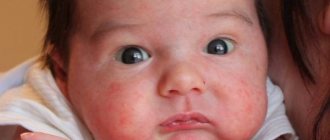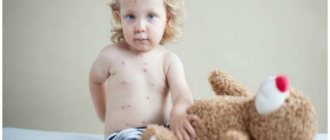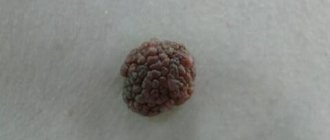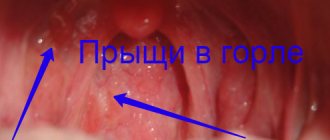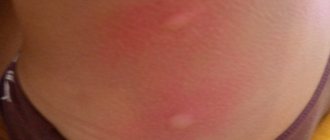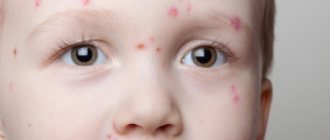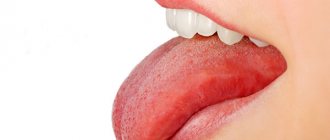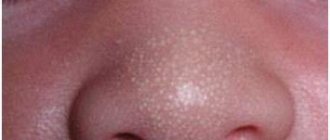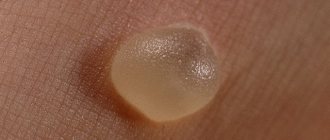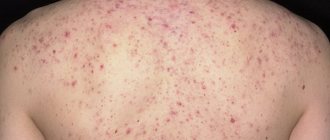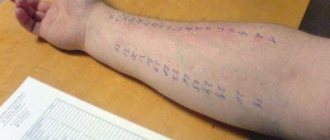Why does a child develop pimples on his butt, how to treat them?
Children's skin is very delicate, so it is often exposed to irritants.
The rash is common and can appear at any time. Depending on the age of the child, the causes of rashes may vary. Sometimes this can be a signal of improper hygiene or the development of pathological processes in the body. To rule out a number of serious diseases, the child must be shown to a doctor.
A child has pimples on his butt - reasons
There are many factors that can lead to the appearance of rashes on children's skin. First of all, it is necessary to pay attention to the nature of the rash, the degree of damage and the age of the child.
In newborns
- One of the causes of pimples in newborns is diaper dermatitis. This disease is an inflammation of the skin in the buttock area. The cause of the development of dermatitis is considered to be poor hygiene and prolonged exposure to dirty diapers. ammonia contained in mole and feces irritates the baby’s delicate skin, which leads to rashes.
- A common cause of acne is an allergic reaction to care products (wipes, soap, diapers). In order to avoid allergies, it is advisable to choose products without fragrances and intended for children.
- Pimples around the anus may indicate a food allergy.
therefore, the diet should be reconsidered. - Staph infection is also a cause of the rash. it can appear not only on the child’s buttocks, but also on other mucous membranes.
- Another reason is climate.
the rash often appears due to inappropriate temperature in the room where the child is. If your baby sweats, rashes can appear on any part of the body.
in children of the first years of life
In the first place among the causes of rashes are allergies and poor hygiene. At this age, parents should actively monitor the baby’s health and instill in him knowledge about personal hygiene.
At the age of 1-2 years, the baby is taught to go to the potty, but it takes time until the child himself asks to go to the toilet. Parents need to change their baby's underwear on time to prevent rashes.
The first years of life involve a transition to a normal diet. Because of this, problems often arise with the child’s digestive system. rashes become a reaction to certain foods, so it is necessary to monitor the general condition of the baby and his stool.
Parents should be alerted to the presence in stool of:
- bleeding;
- mucus;
- white clots.
The presence of the above symptoms may indicate dysbacteriosis. If there is abdominal pain, loss of appetite and restlessness in the baby, then gastrointestinal diseases or helminth infection may develop.
Another cause is considered to be infectious diseases: scabies, candidiasis, scarlet fever, measles, rubella. If an infection occurs in the baby’s body, the rash affects not only the butt, but also other parts of the body.
if redness appears after going outside, then a possible cause is hypothermia. To protect yourself from the cold, you should choose the right clothing.
from 2 to 6 years
From the age of 3, a child is enrolled in a kindergarten where other children are, and the risk of contracting an infection increases accordingly. At this time, it is important to strengthen the baby’s immunity.
To avoid hypothermia, walks in the fresh air should take place for a set period of time; you should not sit on cold benches or other surfaces. The anus area is sensitive to low temperatures, so it is important to keep the baby's body warm.
To prevent rashes, you need to choose clothes made from natural fabrics. You should avoid synthetic fabrics that do not conduct air and do not allow the skin to breathe.
at this age, the rash appears due to poor personal hygiene, eating unwashed fruits and vegetables, as well as large amounts of sweets.
after 7 years and older
at an older age, in some cases the child can explain and eliminate the cause of the rash on his own (for example, change underwear, take a shower).
Infectious diseases are less common, since children by school age have a number of vaccinations that protect them. The older the child becomes, the easier it is for him to explain the area of discomfort, make a diagnosis accordingly and eliminate the rash.
The cause of the rash may be puberty, during which hormonal levels become disrupted. The peak of change in a child’s body occurs individually, so it is impossible to determine the exact age of maturation. It should be remembered that in modern children growth begins much earlier.
The next reason for a rash on the butt is stress and overexertion. The first time at school can be a real test for a child due to adaptation to the environment and a new team. doing homework, bad grades and separation from parents often upsets the baby, which can lead to health problems.
sudden changes in air temperature also cause rashes. the most dangerous period is autumn and spring, when the temperature outside changes throughout the day. Parents should monitor the child’s clothing, avoiding overheating and hypothermia.
Eating large amounts of sweets and fast food has an adverse effect on the condition of the child’s body, in particular the skin. As a result of metabolic disorders, the child may develop rashes on the buttocks.
types of acne in children on the buttocks
Depending on the type and appearance of acne, you can determine the cause of its appearance.
Reds
If red pimples appear in a child, they are diagnosed with:
- diaper dermatitis;
- heat rash;
- allergies.
In order to distinguish the cause of the rash, you should remember the main differences between the diseases.
- Diaper dermatitis is characterized by a rash of small pimples on various parts of the body. The red spots may have a watery content that turns into a crust over time. Dermatitis occurs due to improper hygiene and greatly worries the child. Because of the burning sensation, the baby becomes restless and often cries;
- with prickly heat, pimples are located on different parts of the body, without touching each other and without inflaming the skin;
- the allergy manifests itself immediately throughout the entire buttock area. After a few days, the pimples dry out and the skin begins to peel. If rashes are not treated promptly, wounds and cracks may form, which cause the development of bacteria.
Red pimples appear as a result of the development of infectious diseases:
It should be remembered that during infections, rashes on the buttocks appear last.
White
White pimples rarely contain pus or other substances, so they do not cause inflammation.
They appear as a result:
- poor hygiene;
- incorrectly selected clothes;
- hypothermia.
Such rashes do not threaten the child’s life and usually go away on their own. Parents should be alerted to a rash that does not go away within 2 weeks.
Purulent
Purulent pimples are easy to diagnose due to their white, yellow or green head. Often a rash indicates inflammation.
Such rashes should alert parents, since the appearance of pus indicates the presence of staphylococcus. In this case, it is important to start treatment on time, otherwise the infection may penetrate deep into the skin and blood.
Under no circumstances should pustules be crushed.
Watery
A watery rash often occurs in infants and is caused by staphylococcus or streptococcus bacteria.
The disease occurs in several stages:
- red spots appear, which after a few days turn into a bubble with transparent contents;
- The liquid turns yellow over time and turns into pus.
Watery pimples require immediate treatment. In some cases, bubbles may indicate the presence of dermatitis or allergies. When you have chickenpox, the rash spreads throughout the body from top to bottom.
What diseases cause acne on a child's bottom?
The appearance of a rash on a child’s buttocks may indicate the presence of infectious diseases:
- Rubella is characterized by the appearance of small pink rashes.
- Measles. Small bright red dots appear all over the body, first on the face and arms, then down to the butt.
- Scarlet fever. The symptoms are similar to measles. Red pimples, high fever and sore throat appear.
- Roseola. Characterized by the presence of high fever and pink pimples.
- Chickenpox. During illness, small blisters appear throughout the body, which eventually turn into crusts.
Infectious diseases very quickly affect a child’s body, so it is important to diagnose and begin treatment in a timely manner.
How to treat acne on the buttocks in children?
It should be remembered that the treatment of acne on the butt depends on the diagnosis and the age of the child. In any case, you should not self-medicate and squeeze out pimples. Complex therapy is often required, which includes the use of medications and personal hygiene.
Drug treatment
Medicines must be prescribed by a doctor. Vitamin complexes, as well as products high in calcium and magnesium, are often used.
To treat purulent pimples, zinc ointment or salicylic alcohol is prescribed. Children after one year of age are allowed to use medications.
“Zinerit” is used to treat acne on the butt. It is applied to clean skin 2 times a day. An analogue of “Zinerit” is “Skinoren”; it also fights purulent pimples well.
The drugs should not be used to treat children under 3 years of age.
Traditional methods
Traditional medicine for the treatment of acne on the butt allows the use of:
- chamomile;
- soda;
- oak bark;
- bay leaf;
- calendula;
- potassium permanganate.
Chamomile, calendula or oak bark should be mixed with boiling water. This decoction has anti-inflammatory and antiseptic effects. Use baking soda to treat babies with caution, as a large dose can dry out the skin.
Hygiene rules
To prevent acne from appearing on your baby’s bottom, you should follow these rules:
- change underwear and diapers in a timely manner;
- use natural products to wash your baby;
- infants are washed after each trip to the toilet;
- To wash children, use soft sponges and napkins so as not to irritate delicate skin;
- regularly moisturize your baby’s skin with creams;
- monitor the child's nutrition.
What to do if pimples itch?
Itching can be caused by:
- skin irritation;
- allergies;
- scabies.
The first thing to do is to prevent scratching your pimples. Your child's nails should be trimmed short to reduce the risk of skin damage.
The affected areas are covered with thick clothing. Before the doctor arrives, lotions made from green tea, mint or lemon balm will help reduce itching. Such tinctures should be used if the child does not have allergies.
With proper treatment, a rash on children's skin does not cause serious consequences. The main thing is to follow all the doctor’s recommendations and take preventive measures to prevent repeated reactions. It should be remembered that formations on the skin do not appear out of nowhere, so it is important to establish the cause of their appearance.
Source: //skindiary.ru/zabolevaniya/pryshhi/pryshhi-u-detej-na-yagodicax.html
What they look like
By the appearance of acne, you can determine the problem that caused it.
Of course, parents cannot always independently determine whether it is an allergic rash or prickly heat. But a specialist just needs to look at acne to understand what is causing it.
Reds
The rashes, at first glance, are quite similar.
They can be distinguished by the following characteristics:
- With diaper dermatitis, small pimples are located in areas that in appearance resemble large red spots. This occurs due to skin irritation. Pimples may have watery contents that come to the surface and turn into crusts. When contacting urine, the child will experience an unpleasant feeling, a burning sensation. He will talk about it with worry, crying;
- With prickly heat, pimples look like separate elements. They do not merge with each other and the skin between them is not inflamed;
- allergic rashes are usually located symmetrically on the buttocks, that is, they will appear on both the left and right sides. Areas with the rash may be red, but they usually quickly become dry and begin to peel. If a child scratches these areas, cracks and abrasions may form on them, which increases the risk of bacterial infection.
Red pimples can also appear as a result of infectious diseases such as measles, rubella, but, as mentioned earlier, the rash is not the first place to appear on the buttocks.
So usually the disease can be diagnosed before the rash on the butt becomes noticeable.
White
Dermatologists usually call white pimples rashes without signs of inflammation and without purulent contents.
They usually have no content at all, representing so-called papules.
Typically, white pimples are not a serious symptom.
- They can appear due to insufficient hygiene if dead skin particles are not exfoliated in time.
- The same rashes can appear due to wearing synthetic underwear or hypothermia.
Purulent
Purulent are pimples with a white head.
They are usually inflamed, that is, the skin around the tip is red. The contents may be not only white, but also yellowish or greenish.
In this case, parents need to worry.
The most striking example is vesiculopustulosis - damage to the skin by this type of bacteria. The condition may become more complicated if the infection penetrates into the deeper layers of the skin or spreads through the blood throughout the body.
Squeezing out pustules or lack of treatment can contribute to such an unfavorable development of infection.
Pimples on the bottom of a child, causes of red pimples in children
Rashes and rashes in a baby can appear for a variety of reasons. This could be a common allergy or an infectious disease. Acne in children is a serious problem that can appear completely suddenly. And every mother, noticing a rash on her skin, begins to sound the alarm. Do not do this. The task is to recognize the cause and carry out treatment.
Types of acne
The appearance of pimples is one of the body's ways to adapt to changes. Occurs in children of any age. Parents should be able to determine the type of rash, as well as know the cause of the formations. Regardless of age, experts distinguish two types of acne: non-infectious and infectious. The first category includes:
- Prickly heat;
- white dots;
- spots or macules;
- papules;
- allergic reaction (there are two types: food and contact);
- neonatal acne in babies;
- pustules.
Infectious pimples are considered dangerous and must be treated immediately.
Pimples in young children
Sudden rashes are a cause for concern for any mother. First, she tries to understand what caused them to appear, and only then proceeds to treatment. First of all, you need to analyze the child’s diet.
After all, most acne occurs due to an allergic reaction. As a rule, after eliminating allergens, redness disappears. But if this does not happen, then you need to consult a doctor.
Acne in newborns and children of the first year of life
In the first days of a child's life, the skin may suddenly become covered with pimples. The rash can be red and white and cover isolated areas or the entire body. In order not to puzzle over why pimples formed, you need to know the reasons for their appearance.
- White pimples are more common in children under one year of age. They are very small and about the size of a pore in the skin. These rashes are called milia. This disease is easy to cure. It is important not to rub or squeeze, as bacteria can get inside the skin. The rash goes away on its own after about one month.
- Also, white rashes usually appear due to an excess of maternal hormones. They affect the skin, which is why babies develop hormonal acne. Most often, the rash appears on the face, but can also affect other parts of the body.
- Excessive activity of the sebaceous glands is another significant factor in the appearance of acne in young children. Immediately after birth, the sebaceous glands are activated, which is where various rashes begin to appear. Such pimples can appear immediately after birth and disappear within a month.
- Allergic reactions also affect the skin, causing inflammation. Red rashes appear due to a product eaten by the mother, which enters the baby’s body through breast milk. Allergies require medical intervention, so at the first symptoms you should immediately contact a specialist.
Diseases that cause acne
Don't think that your baby's skin will be smooth and velvety like in advertising. Skin rashes and pimples are a common occurrence among babies. But it should be distinguished when the rash appears due to illness. If in doubt, it is necessary to show the child to a doctor.
A baby's skin is sensitive, so it reacts to literally everything. Diseases that cause redness of the skin are:
- Drug rash. Occurs after taking medications (antibiotics, hormonal drugs, etc.). Vitamin complexes, fluoride, iron and other herbal preparations can also provoke rashes.
- Food allergies. It appears as a pink or red rash similar to nettle sting. They are most often seen on the chin and cheeks, but also appear on the stomach, legs and back. If the child is breastfed, then the reason lies in the mother’s diet.
- Contact dermatitis. It resembles fine salt. Pimples appear in response to washing powders and rinses. Children's clothing (wool or synthetics) can also trigger the appearance of a rash.
- Diaper dermatitis. The first symptoms are redness, peeling and blistering. They appear in the diaper area. the reason is prolonged contact with wet fabric or folds in diapers.
- Prickly heat. It occurs at any time of the year and looks like a small pink rash. Most often it affects the neck and chest area. The reason lies in prolonged sweating of the skin. This type of disease is not dangerous and therefore does not cause negative feelings in the child.
- Atopic dermatitis. Refers to allergic diseases. The reasons are varied: incorrect menu for a nursing mother, complementary foods introduced at the wrong time, dysbacteriosis, hereditary predisposition, irritating cosmetics. Atopic dermatitis in a baby begins with a slight swelling on the forehead and cheeks.
- An infectious rash that occurs due to infectious diseases. Varies for each type depending on the disease. This is infantile roseola, which is also called “sudden exanthema.” Children under two years of age are most often affected. This also includes scarlet fever, which is a small scarlet rash. Don't forget about chickenpox and measles.
We recommend: Signs of measles in a child
How to treat acne on a child's bottom?
There are many recipes that are used to treat inflammation of a baby’s bottom. The most accessible are pharmaceutical ointments and creams, which often have questionable composition. You can prepare an environmentally friendly product at home. A mixture of medicinal herbs will help remove inflammation on a child’s bottom.
To prepare you will need:
- Yarrow - 3 tablespoons;
- nettle leaves (dioecious) – 6 tbsp;
- stinging nettle – 1 teaspoon.
Mix all the herbs and pour 0.5 liters of boiling water. Everything is infused for about one hour. Then you need to strain and apply to the affected areas twice a day.
For children over two years old, a saline solution is good. The best option is to use sea salt. You need to prepare an infusion based on mineral water. Apply twice daily using a cotton pad. Raspberries are a good anti-allergenic remedy. Boil the raspberry rhizomes for about an hour, cool and give the child 25 ml in the morning and evening.
It is also important to maintain hygiene and care for the baby. Be sure to change the brand of diapers if your allergy to your butt is caused by them.
Pimples always cause discomfort, especially for small children. They can be of different types and types. If you notice a rash on your baby, then you shouldn’t panic and self-medicate.
After all, the rash could be caused by overheating of the body. In such cases, you need to wash the baby with warm water.
If the redness does not go away, and the child’s well-being worsens, then you should immediately contact a specialist so that he can prescribe competent treatment.
Source: //DetMed.info/pryshhi-na-pope-u-rebenka
Folk remedies
Many rashes on the skin of the buttocks can be quickly cured using traditional methods.
This is especially true for prickly heat and diaper dermatitis.
Photo: decoctions of medicinal herbs can be added to a bathtub
- Decoctions of medicinal herbs help with them - chamomile, string, sage, birch buds. They can be added to baths, used for rubbing and compresses.
Photo: for allergies, it is useful to use a decoction of bay leaves
- For allergic rashes, an infusion of bay leaves will provide good help. Place a dozen leaves in a small saucepan, add 1 liter of water and boil over low heat for 15-20 minutes. Then cover with a lid and let cool. You can wipe the areas with rashes with this infusion several times a day, and also add it to your evening bath.
Photo: a bath with sea salt is useful for rashes in children over two years old
- A sea salt solution has a good effect on damaged skin. Take 5 tablespoons of salt per liter of warm water and dissolve it. Sea salt can be used for compresses, rubbing, and baths. It is used in children over 2 years of age.
Pimples on the bottom of a 9 year old child: causes
Acne on a child’s body can be both a symptom of an illness and its consequence. That is why this problem cannot be left without due attention.
If you find any rashes on your baby’s body, you should immediately consult a doctor to find out the cause of their appearance.
We will look at the most common types of acne that can occur in young children, as well as the main reasons for their formation.
Acne (acne vulgaris) is a dermatological disease characterized by disturbances in the functioning of the sebaceous glands. Due to increased sebum secretion, the pores on the skin can become clogged, which leads to inflammatory processes. For this reason, pustules (pustules), acne, blackheads (comedones) or single pimples form in the upper layers of the epidermis.
In children, acne primarily affects the face and back; in newborns and babies up to one year old, acne mostly forms on the butt, which is associated with diaper rash; in adolescence, suppuration occurs most often on the face, shoulders, and back.
By themselves, inflamed nodules in the upper layers of the dermis do not pose a threat to life, but after they disappear, pigment spots may remain, which is not very aesthetically pleasing.
Acne and pimples on the body in children can appear for various reasons.
- Allergic reaction. Red rashes often occur in case of an allergic reaction. The baby's sensitive skin reacts to almost any negative changes in the body's condition, which leads to the formation of a rash.
- Puberty. During puberty, active development of the body occurs, which is associated with the formation of secondary sexual characteristics. This leads to quite serious changes in hormonal levels. Such changes are often accompanied by the appearance of acne on the back, face, and shoulders.
- Reaction to an insect bite. Usually the redness does not contain pus, but can cause severe itching and an allergic reaction, as a result of which purulent rashes may already appear in the bite area;
- Wearing synthetic clothing. Often, pustules on the back, as well as in the lumbar region, indicate a negative reaction of the skin to contact with synthetic materials;
- Prickly heat. Under the influence of a sufficiently high ambient temperature, the skin begins to actively sweat and produce more natural oil, which leads to clogged pores. This, in turn, causes inflammation, resulting in the formation of pustules on the shoulders and chest.
- Lack of hygiene. Your baby's sensitive and thin skin needs careful care. When heavily soiled, the risk of infection for the child increases significantly, which can lead to the formation of inflamed nodules on the skin.
- Acnemorphic rash. Acne appears in newborns due to the fact that the mother took medications that included lithium or steroids during pregnancy.
- Infectious diseases. Pimples on the face and body in children often form due to infectious diseases such as chickenpox, rubella, scarlet fever, urticaria, etc.
- Dysbacteriosis. In this case, pustules most often appear in the hairy parts of the body, as well as on the face. They often cause itching or burning.
- Staphylococcal infection. Actively reproducing staphylococci cause inflammation, as a result of which small red-white suppurations appear on the skin, all over the body.
- Reaction to vaccination. Quite often, acne appears after vaccinations in children of primary and school age, however, such a reaction is purely individual and depends on the child’s immune resistance.
Obviously, the causes of acne can be very diverse. Some of them are associated with infectious diseases, while others are caused by external factors. Therefore, if you detect inflamed formations in your baby, you should first contact a specialist.
Skin rashes can look different, due to various reasons that influenced their appearance. Some of them form a whole group of inflamed nodules, while others form local foci and disappear in just a couple of days.
To roughly understand what type of rash you are faced with, let’s look at the most common ones.
- Watery rash all over the body. Pustules with reddened edges may be a manifestation of chickenpox. Over time, their number increases and they can appear on any part of the body;
- Pimples on the butt. Occur due to constant wearing of diapers made of synthetic materials, which cause irritation;
- Rash on arms and legs. The occurrence of acne in these areas of the body most often indicates dyshidrosis;
- Pink-red watery formations. If pimples form at the site of redness within a couple of hours, most likely we are talking about streptoderma;
- Pimples with blackheads. A similar symptom indicates the presence of molluscum contagiosum;
- Pale red formations in the chin area. Most often they occur in babies during teething. Their appearance is caused by excessive salivation, which irritates the skin.
After acne appears, you should immediately consult a doctor, even if you think that the rash is not dangerous. In fact, the main problem lies in the fact that inflamed nodules are often the result of serious diseases, the success of treatment of which depends on the degree of “neglect” of the disease.
If a child has pimples all over his body, the doctor will prescribe treatment with medications that will reduce itching and burning, and also prevent the formation of new acne. Drug treatment can occur using the following medications.
- Baby powder and Bepanten will help get rid of diaper rash and small inflamed nodules.
- Baths with a weak solution of potassium permanganate, which will dry out the pustules and normalize the functioning of the sebaceous glands.
- To combat allergic manifestations, a special diet and medications will be prescribed to relieve allergy symptoms.
- To get rid of acne that appears due to increased sebum secretion, you can wipe the affected areas of the skin with a solution of furacycline.
- To more quickly restore the integrity of the skin, doctors advise taking multivitamins.
If your child has pimples on their body, first consult a doctor. He will determine the cause of their occurrence, so he will prescribe medications that will contribute to the baby’s speedy recovery.
You shouldn’t leave everything to chance, because most often a rash is not an independent problem, but occurs as a symptom or consequence of another disease.
Share the link with your friends
Source: //detki.shukshin-net.ru/pryshhi-na-pope-u-rebenka-9-let-prichiny/
What to do if you itch
Acne that appears on the buttocks can itch due to:
- skin irritation;
- allergic nature of rashes;
- infection with demodex (subcutaneous mite) or scabies.
Photo: if rashes appear on the body, the baby should be examined by a doctor
In this case, it is better to consult a doctor.
- Before visiting him, you should monitor your child so that he does not scratch his skin. To do this, first of all, you need to trim his nails and cover the part affected by pimples with thick clothing.
- Freshly brewed green tea, which should be used to wipe pimples, will help reduce itching. A decoction of mint or lemon balm will also be effective, of course, if the child is not allergic to these herbs.
Pimples on the bottom of a 9-year-old child: causes and treatment – Mishutka
Pimples on a child’s body always cause alarming concerns among parents. This is a completely justified fear, because in the first months and years of life, babies do not experience hormonal changes or disruptions in the body, which means that the cause of red rashes can be anything.
Oh these beautiful babies
However, pediatricians advise young parents not to panic at the first manifestations of a rash. It is important to ensure the child has good hygiene and proper nutrition.
It happens that children's skin is affected by white pimples called “milia”. They are formed due to blockage of the sebaceous glands - a normal reaction of the body of a newborn. In order not to confuse milia and another disease, you need to remember that in the first case the baby maintains a good appetite and normal temperature.
After 2-3 months, white pimples disappear on their own. The child's body is easily susceptible to various ailments that provoke skin rashes, so you need to know the features of the most common phenomena.
Causes of acne in children
Acne in a child can appear for several reasons:
- Excess hormones cause a sudden rash that disappears after a few days. This is normal in babies and does not need to be treated. If acne does not go away for a long time, it means that hormonal levels cannot stabilize. In this case, you need to consult a doctor.
- High humidity in the room negatively affects the baby's health. It is important to establish a normal level of humidity in the apartment and monitor the condition of the child’s skin. Acne on the body will completely disappear.
- The development of sebaceous glands occurs in the first months of life. White pimples on a child’s face do not cause him any discomfort and will soon go away without treatment. The main thing is to ensure that the rules of hygiene and proper nutrition of the baby are observed.
- An allergic reaction to food, care products and changing infant formula causes redness and slight itching. If a child is fed breast milk, allergies may be triggered by some foods consumed by the mother. It is necessary to stop using cosmetics for a while to check the baby's reaction. If the pimples don’t go away, then the problem is different.
- Red pimples are often caused by weather conditions to which the child is not yet adapted.
- Disorders in the digestive system.
- Rubella, measles, scarlet fever.
Pimples on the surface of the face
Pimples on the face can have different shapes and colors. Some inflammations do not cause itching and pain, but increase in number every day. This is usually a reaction to diathesis or certain foods.
However, if the baby begins to persistently scratch his face and act up, this is a sure sign of the onset of chickenpox. Small pimples on the face turn into larger blisters and spread throughout the body. The same phenomenon may foreshadow scarlet fever or measles.
The girl has pimples on her face
It is important to determine the nature of pimples in time and consult a doctor. It is necessary to explain in detail to the pediatrician the time of formation of the rash and the baby’s behavior so that the doctor can make the correct diagnosis and prescribe treatment.
Rash on the body
Pimples all over the body occur due to external factors and infectious diseases. The rash covers the stomach, legs, butt, and arms. Provoking factors are:
- Chickenpox: characterized by light-colored pimples with fluid inside, fever, and general discomfort. In this case, you need to call a doctor rather than go to the clinic, since there is a high probability of infecting other children. It is important to give your baby natural drinks and light food.
- Scabies: easily identified by a doctor and quickly treated. A rash spreads throughout the body, causing severe burning and itching. Scabies can be soothed with herbs, but the disease can only be completely cured with medications.
- Pimples on a child's bottom most often appear due to diapers. When wearing a diaper for a long time, the skin begins to overheat, causing acne to form. In this case, you need to wear diapers less often, allow the skin to breathe freely, and wash with warm water and a decoction of chamomile and string.
Pimples on a child’s bottom can be a signal for the development of an infectious disease, so it is important to consult a pediatrician in a timely manner.
Pimples on a child's tongue
This is a fairly common phenomenon in childhood. As a rule, inflammation occurs due to thrush. The oral mucosa is affected by a fungus, which causes painful acne. In this case, self-medication is contraindicated.
The child's tongue must be clean
Acne in children can be eliminated using safe cosmetics, since in most cases the rash is caused by overheating of the skin. Powders, baby soaps and oils, and creams are used. All these products are made specifically for delicate children's skin, therefore they do not contain harmful chemicals and are impregnated with vitamins, bioactive additives, etc.
The following methods are used to eliminate baby pimples:
- Baby soap should contain herbal extracts. Chamomile and chamomile have a calming effect. After bathing your baby, rinse thoroughly any remaining soap to avoid skin irritation.
- The powder contains talc, zinc oxide, herbal extracts and menthol for a cooling effect. The powder should be used with caution so as not to dry out the baby's skin. It is important to remember that you should not try to remove pustules on the body yourself, nor should you use powder on the affected skin.
Useful tips
To prevent rashes on children's skin, you should follow these tips:
- Use only special hygiene products intended for children of a certain age.
- Children's clothes should be washed separately from adults, and with individual powder specifically for such purposes.
- Boil toys and feeding bottles regularly.
[ width=”720" height=”315"]JLOM3K3aFAs[/] [/]>
- If small pimples occur, you can bathe the baby in water with a weak solution of potassium permanganate.
- Residues of food must be washed with a cotton napkin soaked in boiled water.
Source:
Photo: Types of rash
See how to get rid of acne. What is acne vulgaris? Find out further.
What to do if acne is on your face?
The answer is here. The occurrence of large pimples on the butt should be taken seriously. Often the skin in this area moves or is subject to pressure, which can cause painful swelling to cause severe discomfort. Therefore, it is necessary to begin treatment immediately before the cavity ruptures, spreading the infection.
Basic rules of hygiene
With the help of daily hygiene procedures, you can not only prevent the appearance of acne, but sometimes also cure the following:
Photo: daily hygiene procedures will effectively combat the appearance of rashes
- daily shower, wash off dirt with just water, use baby soap once or twice a week;
- When taking baths, do not rub children’s skin with washcloths; it is better to use cloth napkins or soft terry mittens;
- During the day, the child should take air baths at least 2-3 times a day, more often in hot weather;
- special protective creams are used under the diaper; you can use regular baby cream without fragrances;
- new foods are introduced into the baby’s diet gradually in small portions;
- washing children's clothes should be carried out using products specially designed for this purpose;
- the bottom layer of clothing on a child should always be made of cotton;
- wet diapers or nappies should be changed promptly.
Rashes on the butt in children are usually not very dangerous.
Most often, they indicate some errors in care or nutrition. But still, they cannot be ignored.
Any damage to the skin can cause complications, so when the first symptoms appear, measures should be taken immediately.
